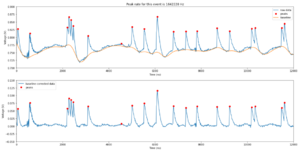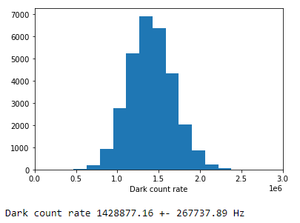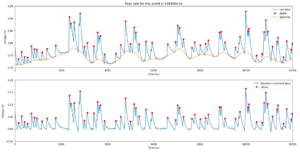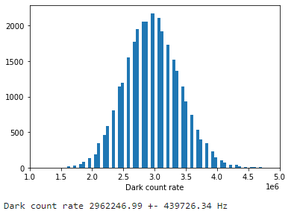Difference between revisions of "Dark count measurements"
m |
m (Move images) |
||
| Line 2: | Line 2: | ||
== VUV SiPM 1821 == | == VUV SiPM 1821 == | ||
| − | On 17-11-2022 we recorded with a room temperature of 17 degrees Celcius. We took 20 times a set of 1000 waveforms and 1 set of 10,000 waveforms at a pressure of 7.4x10^-5 mbar. We also took two noise runs where after starting the run normally, the SiPM bias was turned off. We select single photo-electron peaks with a simple threshold argument, and compute the rate of all combined dark count data. This gives us a dark count rate of 1.4+-0.3 MHz. | + | On 17-11-2022 we recorded with a room temperature of 17 degrees Celcius. We took 20 times a set of 1000 waveforms and 1 set of 10,000 waveforms at a pressure of 7.4x10^-5 mbar. We also took two noise runs where after starting the run normally, the SiPM bias was turned off. We select single photo-electron peaks with a simple threshold argument, and compute the rate of all combined dark count data. This gives us a dark count rate of 1.4+-0.3 MHz. The rate is in agreement with what we would expect. Note that the dark count distribution is rather broad for a Poisson proces. |
| − | [[File:DcrunVUV1821 2 890.png | + | [[File:DcrunVUV1821 2 890.png|thumb|This is a plot of the raw data. A simple peak-finding algorithm is used to find the peaks (indicated by the red dots). A baseline is fitted (orange) and subtracted to produce the bottom plot.|alt=]] |
| Line 11: | Line 11: | ||
| − | [[File:DCrate VUV1821.png | + | [[File:DCrate VUV1821.png|thumb|A histogram of all combined 30000 waveforms, where the rate for each waveform is calculated separately and based on the single pe pulses.|alt=]] |
| Line 29: | Line 29: | ||
== VIS SiPM 01 == | == VIS SiPM 01 == | ||
| − | On 18-11-2022 we recorded with a room temperature of 18 degrees Celsius. We took 20 times a set of 1000 waveforms and 1 set of 10,000 waveforms at a pressure of 6.3x10^-5 mbar. We also took two noise runs and one run with the lamp turned on at 400nm and slightly opened slits. Note that the SiPM was in fact behind the sample holder and not directly exposed to any light from the lamp. We select single photo-electron peaks with a simple threshold argument, and compute the rate of all combined dark count data. This gives us a dark count rate of 3.0+-0.4 MHz. | + | On 18-11-2022 we recorded with a room temperature of 18 degrees Celsius. We took 20 times a set of 1000 waveforms and 1 set of 10,000 waveforms at a pressure of 6.3x10^-5 mbar. We also took two noise runs and one run with the lamp turned on at 400nm and slightly opened slits. Note that the SiPM was in fact behind the sample holder and not directly exposed to any light from the lamp. We select single photo-electron peaks with a simple threshold argument, and compute the rate of all combined dark count data. This gives us a dark count rate of 3.0+-0.4 MHz. Also, this rate is in agreement with what we would expect. |
| − | [[File:DcrunVIS1 2 890.png | + | [[File:DcrunVIS1 2 890.png|thumb|This is a plot of the raw data. A simple peak-finding algorithm is used to find the peaks (indicated by the red dots). A baseline is fitted (orange) and subtracted to produce the bottom plot.|alt=]] |
| − | [[File:DCrate VIS01.png | + | [[File:DCrate VIS01.png|thumb|A histogram of all combined 30000 waveforms, where the rate for each waveform is calculated separately and based on the single pe pulses.|alt=]] |
Revision as of 16:03, 18 November 2022
We want to characterize the dark count rates of each of our individual SiPMs.
VUV SiPM 1821
On 17-11-2022 we recorded with a room temperature of 17 degrees Celcius. We took 20 times a set of 1000 waveforms and 1 set of 10,000 waveforms at a pressure of 7.4x10^-5 mbar. We also took two noise runs where after starting the run normally, the SiPM bias was turned off. We select single photo-electron peaks with a simple threshold argument, and compute the rate of all combined dark count data. This gives us a dark count rate of 1.4+-0.3 MHz. The rate is in agreement with what we would expect. Note that the dark count distribution is rather broad for a Poisson proces.
VIS SiPM 01
On 18-11-2022 we recorded with a room temperature of 18 degrees Celsius. We took 20 times a set of 1000 waveforms and 1 set of 10,000 waveforms at a pressure of 6.3x10^-5 mbar. We also took two noise runs and one run with the lamp turned on at 400nm and slightly opened slits. Note that the SiPM was in fact behind the sample holder and not directly exposed to any light from the lamp. We select single photo-electron peaks with a simple threshold argument, and compute the rate of all combined dark count data. This gives us a dark count rate of 3.0+-0.4 MHz. Also, this rate is in agreement with what we would expect.



